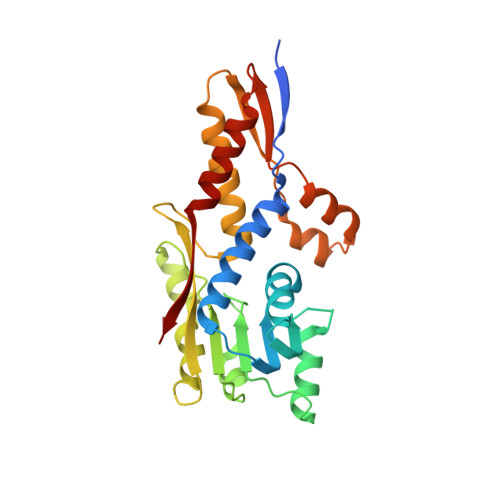Identification of HcgC as a SAM-Dependent Pyridinol Methyltransferase in [Fe]-Hydrogenase Cofactor Biosynthesis.
Fujishiro, T., Bai, L., Xu, T., Xie, X., Schick, M., Kahnt, J., Rother, M., Hu, X., Ermler, U., Shima, S.(2016) Angew Chem Int Ed Engl 55: 9648-9651
- PubMed: 27391308
- DOI: https://doi.org/10.1002/anie.201604352
- Primary Citation of Related Structures:
5D4T, 5D4U, 5D4V, 5D5O, 5D5T - PubMed Abstract:
Previous retrosynthetic and isotope-labeling studies have indicated that biosynthesis of the iron guanylylpyridinol (FeGP) cofactor of [Fe]-hydrogenase requires a methyltransferase. This hypothetical enzyme covalently attaches the methyl group at the 3-position of the pyridinol ring. We describe the identification of HcgC, a gene product of the hcgA-G cluster responsible for FeGP cofactor biosynthesis. It acts as an S-adenosylmethionine (SAM)-dependent methyltransferase, based on the crystal structures of HcgC and the HcgC/SAM and HcgC/S-adenosylhomocysteine (SAH) complexes. The pyridinol substrate, 6-carboxymethyl-5-methyl-4-hydroxy-2-pyridinol, was predicted based on properties of the conserved binding pocket and substrate docking simulations. For verification, the assumed substrate was synthesized and used in a kinetic assay. Mass spectrometry and NMR analysis revealed 6-carboxymethyl-3,5-dimethyl-4-hydroxy-2-pyridinol as the reaction product, which confirmed the function of HcgC.
Organizational Affiliation:
Max-Planck-Institut für terrestrische Mikrobiologie, Karl-von-Frisch-Straße 10, 35043, Marburg, Germany.















